17 Breeds of LOW Maintenance Dogs (with Photos)
While most dog owners enjoy spending time with their pets, some of us eventually have to give our dogs away since we are unable to care for them owing to their high energy needs.
Before getting your dog, you must understand what dog breed suits your family and your lifestyle to choose the right one that will thrive and receive the love it deserves.
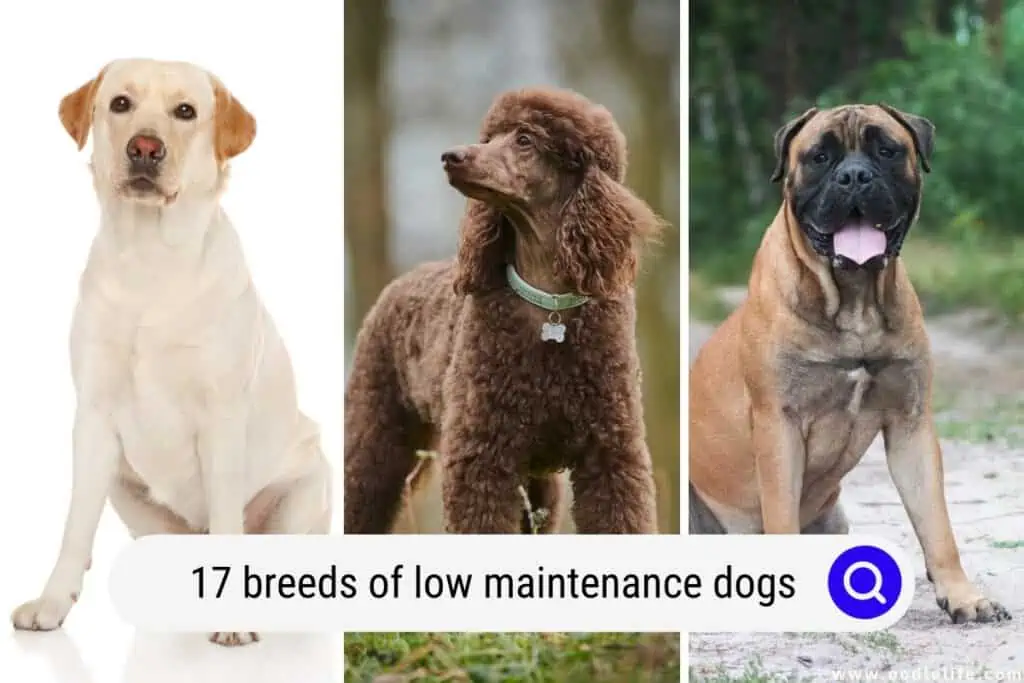
These days, most of us work long hours and don’t have much time to take care of our dogs. Dogs need companionship, grooming, exercise, mental stimulation, and care. Low-maintenance dogs are the best option for dog owners with busy schedules.
They won’t go haywire if you aren’t around for two seconds, and you won’t need to spend as much time attending to them.
Read on to learn about 17 low-maintenance dog breeds you can manage easily. But first, let’s find out what low-maintenance dogs are all about.
What Does It Mean To Have A Low Maintenance Dog?
A low-maintenance dog might mean different things to different people. It might imply that your dog doesn’t shed as much or as frequently, that your dog gets along with young children and elderly family members, or that training is easy.
You will need to consider all of these criteria. We must choose dog breeds that are easy for us to handle and train.
If you have a low-maintenance dog, you can spend quality time with it while also focusing on important things like work or family.

What Factors Should You Bear in Mind When Selecting Your Dog?
If you are ready to add a dog to your home, you should consider the dog’s needs, too.
Important duties to consider include morning and night walks, grooming, brushing, trimming your dog’s nails, bathing, training them, and spending quality time with them every day. Consider how far you stay from a reputable vet, whether there are any dog parks nearby, and whether you have a partner who is just as busy as you and if both of you will be away from home for several hours a day.
These questions are a great place to start, but there are many more factors to consider. The ones we introduced only scratch the surface. Grooming and exercise are the two most important criteria that determine whether your dog requires high or low upkeep.
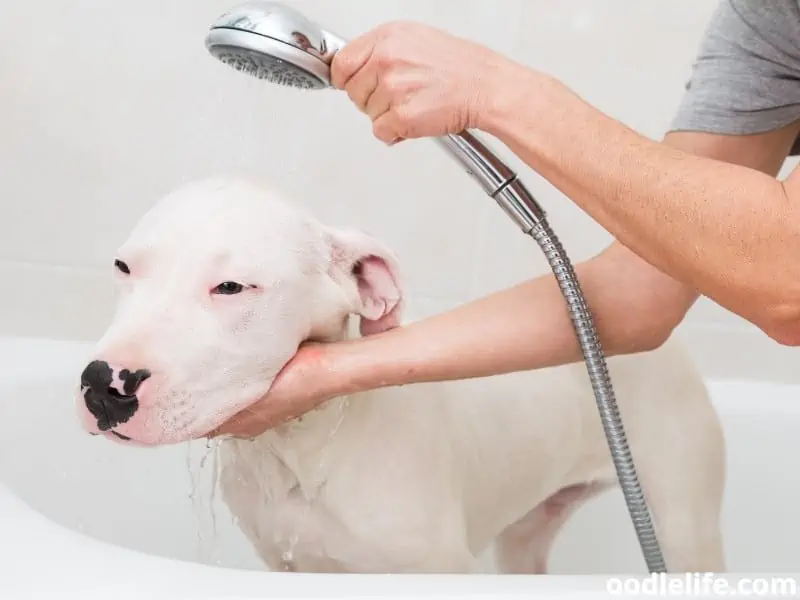
Low-Maintenance Dogs Need Training Too!
Of course, there are low-maintenance breeds, but you can’t expect things to go easy and for them to fit right into your schedule without adequate training.
You need to train your dogs so that they can give you the low-maintenance lifestyle that you desire. Having a well-trained dog ensures that you don’t have to look over your shoulders constantly to check on their behavior.
Let’s say you adopt a low-maintenance dog; you can’t expect it to be at its best behavior the very first day. You must realize that a fair share of your efforts and time goes into helping your dog reach its full potential as a low-maintenance dog.
However, once you and your dog establish a regular pattern that includes fun, training, exercise, mealtime, and some downtime, you can be sure that they’ll settle down and appreciate the simple life.

Top 17 Low Maintenance Dog Breeds
1. Labrador Retriever
Families frequently choose Labradors as their canine companions. The Labrador Retriever is adorable, loyal, and cuddly.

It is a very playful dog that only wants to have a good time with you and your family. It will undoubtedly become your lifelong best buddy because it is dependable and loving.
The best thing about this breed is its strong desire to please, making it easy to train and friendly.
However, it takes a lot of effort on your part to develop a loyal bond with a Labrador, which includes exhibiting exemplary leadership and patience.
A bored Labrador can become incredibly destructive, which inevitably results in chewing and biting your furniture. Also, despite having short hair, these canines shed a lot. They need adequate exercise and cognitive stimulation to be at their best.
Labrador Retrievers’ devotion, wit, and intellect do, however, contribute to their low-maintenance characteristic.
2. Standard Schnauzer
If you’re considering getting a Schnauzer, you’ll undoubtedly be aware of its origin, its huge heart, and limitless supply of energy.
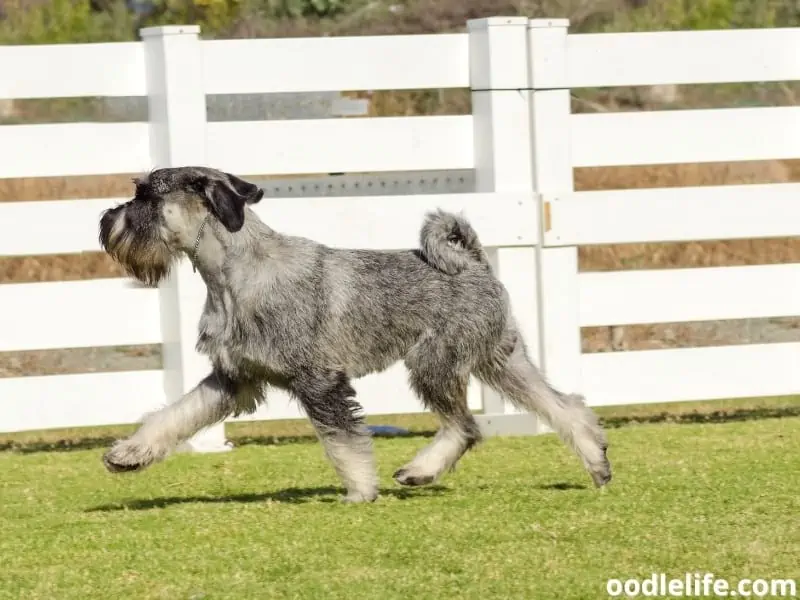
This medium-sized breed resembles its ancestors, the Giant and the Miniature Schnauzer, quite a bit. Like the Labrador Retriever, a Standard Schnauzer requires mental and physical stimulation. Otherwise, it will engage in destructive behavior, like biting and chewing things.
You will need to brush your Schnauzer’s coat three times per week and take it to the groomer regularly.
These dogs may be exceedingly cunning and devious because they are brilliant and well aware of it. So if you think you can handle some mischief, don’t hesitate to get yourself the Schnauzer.
3. Poodles
Poodles are pretty popular dogs. Many people are willing to adopt various types of Poodles due to their trainability and sociability.

You’ve probably seen the extravagant Poodle haircuts, but even if that’s not your style, these dogs still require a bit of maintenance to stay healthy. Besides grooming, they enjoy going on long walks, so keep that in mind if you intend to get a Poodle.
Due to their ability to mimic the activity level of their owners, Poodles are generally known as a breed that requires little maintenance. So, if you avoid being overly playful with your dogs, you can be sure that they won’t get overly excited either.
They are also a hypoallergenic breed and shed less.
4. Newfoundland Dog
Earlier, this breed used to work at docks and fishing boats. But now, you can see these dogs chilling comfortably on the living room couch with their humans.

Although this breed often exhibits placid behavior, it gets active when courage is needed. There are many wonderful tales of this dog saving humans and even other dogs from peril. They are very loyal to their owners.
These dogs weigh between 120 and 160 pounds and can be pretty challenging to handle simply due to their size. However, due to their thick coats, these dogs don’t require much attention in terms of grooming.
These dogs are easy to maintain in the respect that they are lovable, collected, and excellent students.
5. Bullmastiff
The Bullmastiff is a bit of a slacker. Although they’ll never turn down a walk, you can typically find them dozing off or enjoying the sunshine. Surprisingly, they make excellent apartment pets because of their highly placid disposition.
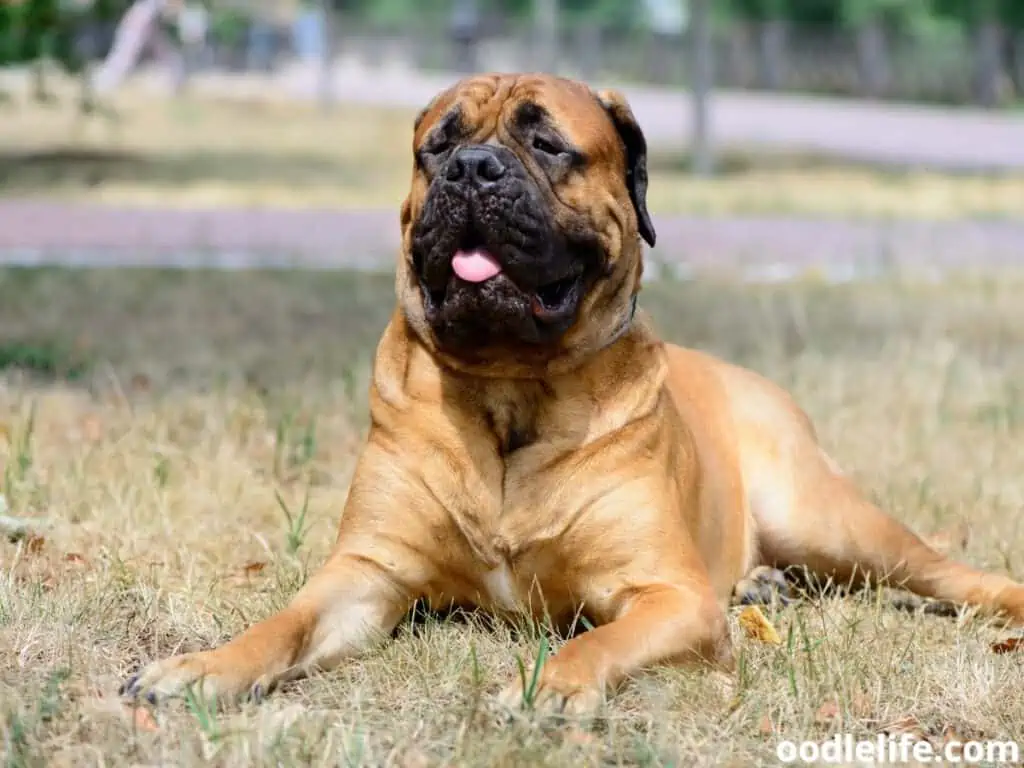
They are easy to groom with their short coats. This dog is your typical low-maintenance dog; at the same time, you need to train it effectively.
Beware, though, training can be difficult as they will test your patience with their obstinacy. They need forceful but fair leadership. Otherwise, they will take on that role themselves.
Early training and socialization are essential to prevent negative behavior and aggression.
6. Rottweiler
The Rottweiler is a German pack hound, so if you plan on getting it, expect it to stick with you while watching TV, going out, or sleeping since it enjoys company. If they fall in love with you, they will be content just lazing around with you at home.

These dogs are low maintenance in that they are quick and intelligent. Once you start teaching them, they pick up things very quickly. They are also calm and won’t start barking until they are 2 or 3 years old.
They tend to look well-groomed as long as you brush their coat every few weeks.
7. Pug
The Pug is a calm, royal dog breed that was bred in China. These dogs only require a good diet and lots of pats, which is why many celebrities have them. They are little, humorous, cute monsters who don’t shed much.

If you have no time to take your dog for a walk, then a Pug is ideal, as it does not require much outdoor exercise. However, you still need to take them out for some activity because they gain weight quickly.
You should also keep your Pug in a cool place because they cannot tolerate temperatures beyond 70 degrees. Aside from showering it with lots of love, taking care of your Pug doesn’t take much effort.
8. Beagle
You must have seen or heard about this breed at some point. Beagles make excellent family pets since they prefer to stay inside, are well-mannered, and respond well to food rewards for “good behavior.”

Beagles don’t bark that much, and they are happy with a short walk around the neighborhood. They do not require regular grooming, which is a bonus.
9. French Bulldog
French Bulldogs genuinely enjoy human contact. They are easy to train and don’t require frequent grooming. This dog would undoubtedly make a fantastic, low-maintenance pet.

However, if you have a pool, ensure it is out of their reach when you aren’t home. This is because French Bulldogs cannot swim due to their large size.
10. Chihuahua
Even in its diminutive form, this dog is a genuine workhorse and amusing. A Chihuahua is more of a one-person dog and, if it perceives a threat, will passionately protect you.

It can be trained to be more friendly and gentle. Due to their small size, they are a low-maintenance breed of dog, but watch out for their aggressive inclinations and gregarious personality.
11. Miniature Pinscher
The Miniature Pinscher is a pretty active dog that can be trained easily with other smaller dogs. If you have children, it’s best not to opt for these dogs, as they expect to be treated gently. But if you want someone to snuggle with after a hard day’s work, the Min Pin is the ideal dog for you.

They just really need to be brushed a few times a week to meet their minimal grooming needs. Keep in mind that if you choose to purchase one, they can be fairly aggressive toward outsiders.
12. Dachshund
If you intend to get a Dachshund, get two, as they tend to be more active and happier this way. They are a bit stubborn, but positive reinforcement will help them get back on track.

As they have short hair, they require little maintenance in terms of grooming. Since they scrounge food, you must watch out so that they don’t eat anything they shouldn’t.
There will be no discussion when they sleep between your covers! These are bright, courageous dogs, yet because of their diminutive stature, many dog owners find them to be a low-maintenance breed.
13. Yorkshire Terrier
The Yorkie makes a cheerful little partner, especially if you are living alone. Positive training approaches make learning easier. You can also maintain their appearance with little effort if you keep their hair trimmed.

Yorkies are little dogs, so they only require a little activity. To help them release energy, engage with them regularly and take them out for walks.
They can live in apartments and are great when it comes to living indoors.
14. English Cocker Spaniel
The English Cocker Spaniel is the dog for you if your family prefers to enjoy time indoors. But of course, it does love its small walks occasionally!

They get along well with other canines, and when grown around cats, they tend to be friendly with them too. The breed is driven to please its owner, so it will be easy to teach your English Cocker Spaniel some basic discipline and fun tricks.
15. Havanese
The Havanese dog is a particularly fantastic breed when it comes to being your companion, especially if you are in need of some cuddling. If you prefer to stay in an apartment, this dog is perfect for you. Just remember to keep it engaged with some simple indoor games!
Although these dogs grow long coats, many owners opt to snip them short to reduce the time and effort that goes into grooming.

16. Greyhound
You might be surprised to see a Greyhound on our list of low-maintenance dogs but believe it or not, they prefer lying around the house and sleeping though they are known for their speed. However, ensure that you take them for walks to the park just to tire them out.
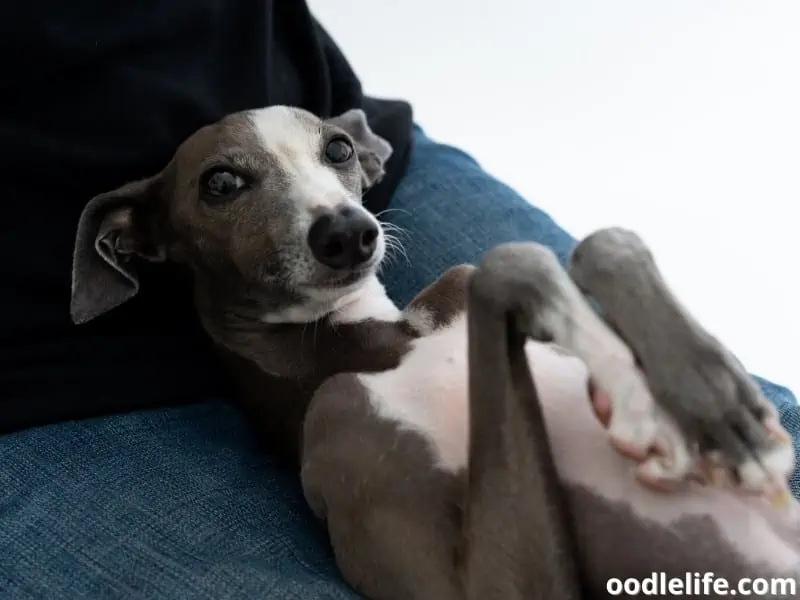
Although they are incredibly devoted and gentle with their owners, these dogs can be somewhat independent. In addition, Greyhounds only seldom shed and require only a bit of maintenance.
17. Puggle
The Puggle is a low-maintenance designer breed that is a cross between Pug and Beagle. They don’t require a lot of space and are laid back. They enjoy playing, but because of their small size, they become tired quickly.

Puggles also thrive on quick walks or indoor activities.
They don’t require much maintenance, which is great news, although they do have a tendency to shed. You can expect them to get along well with children as well as other pets in the house.